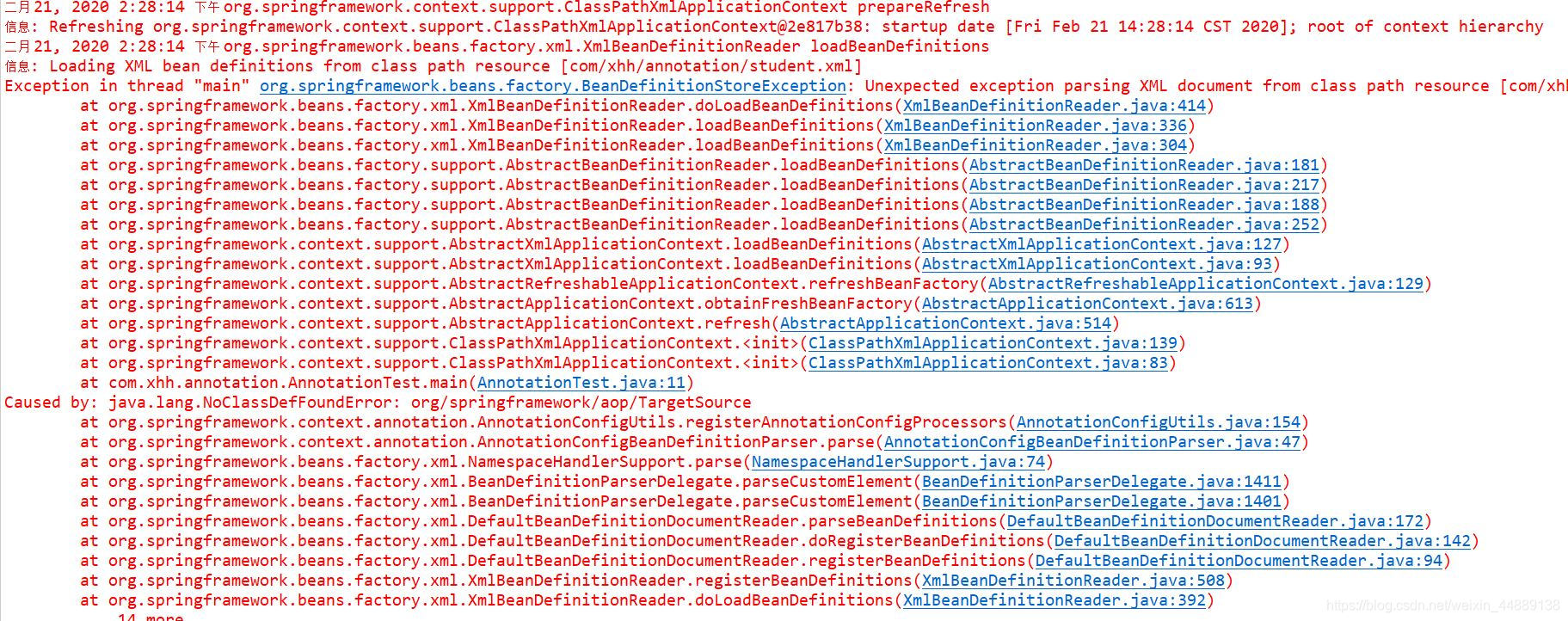继续前一篇
这篇是我感觉最重要的一篇,对我学习Spring Boot有很大启发。。所以我单独分开了。
那就来学习一下Bean的装配方式吧!
Bean的装配方式
1. 基于XML的配置
Spring提供了两种基于XML的装配方式:设值注入,构造注入
-
设值注入
- 原理:Spring首先会调用Bean的默认构造方法来实例化Bean对象,然后通过反射的方式调用setter方法来注入属性值。
- 要求:
- Bean类必须提供一个默认的无参构造方法。
- Bean类必须为需要注入的属性提供对应的setter方法。
- 需要使用
<Bean>的子元素<property>来为每个属性注入值(前一篇介绍)
- 例子:
- 创建一个Web项目,导入所需jar包(所需jar包已讲过),在src中创建包(我创建包名com.xhh.assemble)
- 在包中创建类(我创建类Student),在该类中定义id(String),name(String),list(集合)三个属性及其对应的setter方法(有参数的构造函数为构造注入所用),如下
Student.java类。 - 创建配置文件xml(我创建的Student.xml)利用
<Bean>的子元素<property>设值,在前一篇已讲到。如下Student.xml - 创建测试类,
StudentTest.java
-
构造注入
Student.java
package com.xhh.assemble;
import java.util.List;
public class Student {
public String id;
public String name;
public List<String> list;
/**
* 构造注入
*/
public Student(String id, String name, List<String> list) {
this.id = id;
this.name = name;
this.list = list;
}
/**
* 设值注入
*/
public Student() {
}
public void setId(String id) {
this.id = id;
}
public void setName(String name) {
this.name = name;
}
public void setList(List<String> list) {
this.list = list;
}
// 方便看结果
@Override
public String toString() {
return "Student [id=" + id + ", name=" + name + ", list=" + list + "]";
}
}
Student.xml
<?xml version="1.0" encoding="UTF-8"?>
<beans xmlns="http://www.springframework.org/schema/beans"
xmlns:xsi="http://www.w3.org/2001/XMLSchema-instance"
xsi:schemaLocation="http://www.springframework.org/schema/beans
http://www.springframework.org/schema/beans/spring-beans.xsd">
<!-- 设值注入 -->
<bean id="student2" class="com.xhh.assemble.Student">
<property name="id" value="1002"></property>
<property name="name" value="李四"></property>
<property name="list">
<list>
<value>"PHP"</value>
<value>"IOS"</value>
</list>
</property>
</bean>
<!-- 构造注入 -->
<bean id="student1" class="com.xhh.assemble.Student">
<constructor-arg index="0" value="1001"></constructor-arg>
<constructor-arg index="1" value="张三"></constructor-arg>
<constructor-arg index="2">
<list>
<value>"java"</value>
<value>"Android"</value>
</list>
</constructor-arg>
</bean>
</beans>
StudentTest.java
package com.xhh.assemble;
import org.springframework.context.ApplicationContext;
import org.springframework.context.support.ClassPathXmlApplicationContext;
public class StudentTest {
public static void main(String[] args) {
ApplicationContext context = new
ClassPathXmlApplicationContext("com/xhh/assemble/Student.xml");
// 构造注入
Student student1 = (Student) context.getBean("student1");
System.out.println(student1.toString());
// 设置注入
Student student2 = (Student) context.getBean("student2");
System.out.println(student2.toString());
}
}
*2. 基于Annotation(注解)的配置
尽管使用XML配置文件可以实现Bean的装配工作,但如果应用中有很多Bean,会导致XML配置文件过于臃肿,后续维护/升级带来一定的困难。因此,Spring提供了Annotation(注解)技术的全面支持。
常用注解如下:
| 注解 | 描述 |
|---|---|
| @Component | 此注解描述Spring中的Bean,可作用于任何层次(仅仅表示一个Bean) |
| @Respository | 用于数据访问层(Dao层或者叫Mapper层)的类标识Spring中的Bean |
| @Service | 用于将业务层(Service层)的类标识为Spring中的Bean |
| @Controller | 用于将控制层(如Spring MVC中的Controller) 的类标识为Spring中的Bean |
| @Autowired | 用于对Bean的属性变量,属性的setter方法及构造方法进行标注(按照Bean的类型装配) |
| @Resource | 与Autowired类似,但按照Bean的实例名称装配 (它有两个重要属性name,type) |
| @Qualifier | 与@Autowired配合使用,会将按Bean类型装配修改为按实例名称装配 |
虽然@Respository,@Service,@Controller功能与@Component功能相同,但为了使标注类本身用途更加清晰,建议使用@Respository,@Service,@Controller分别对类进行标注。
演示如何通过注解来装配Bean
- 在Src目录下,创建包(我创建com.xhh.annotation),在包中创建接口
StudentDao.java
package com.xhh.annotation;
public interface StudentDao {
public void writer();
}
- 创建接口的实现类,在类中使用@Repository(“studentDao”)注解将
StudentDaoImpl.java标识为Spring中的Bean。写法相当于<bean id="studentDao" class="com.xhh.annotation.StudentDaoImpl"></bean>
StudentDaoImpl.java
package com.xhh.annotation;
import org.springframework.stereotype.Repository;
@Repository("studentDao")
public class StudentDaoImpl implements StudentDao {
@Override
public void writer() {
// 用于验证是否成功调用了该方法
System.out.println("StudentDaoImpl:学生信息写入成功。。。");
}
}
- 在包中创建接口
StudentService.java
package com.xhh.annotation;
public interface StudentService {
public void register();
}
- 创建
StudentService.java接口的实现类StudentServiceImpl.java,首先使用@Service(“studentService”)注解将StudentServiceImpl.java类标识为Spring中的Bean,这相当于<bean id="studentService" class="com.xhh.annotation.StudentServiceImpl"></bean>,然后使用@Resource(name = “studentDao”)注解标注在属性studentDao上,这相当于<property name="studentDao" ref="studentDao"></property>
StudentServiceImpl.java
package com.xhh.annotation;
import javax.annotation.Resource;
import org.springframework.stereotype.Service;
@Service("studentService")
public class StudentServiceImpl implements StudentService {
@Resource(name = "studentDao")
private StudentDao studentDao;
@Override
public void register() {
// 用于验证是否成功调用了该方法
this.studentDao.writer();
System.out.println("StudentServiceImpl:学习信息注册成功。。。");
}
}
- 在包中创建控制器类
StudentController.java,首先用@Controller(“stuController”)注解标注了该类,这相当于在配置文件中编写<bean id="stuController" class="com.xhh.annotation.StudentController"></bean>,然后使用@Resource(name = “studentService”)注解标注在属性studentService上,这相当于<property name="studentService" ref="studentService"></property>
StudentController.java
package com.xhh.annotation;
import javax.annotation.Resource;
import org.springframework.stereotype.Controller;
@Controller("stuController")
public class StudentController {
@Resource(name = "studentService")
private StudentService studentService;
public void save() {
// 用于验证是否成功调用了该方法
this.studentService.register();
System.out.println("StudentController:学生信息已保存");
}
}
- 创建配置文件XML(Student.xml)
Student.xml
<?xml version="1.0" encoding="UTF-8"?>
<beans xmlns="http://www.springframework.org/schema/beans"
xmlns:xsi="http://www.w3.org/2001/XMLSchema-instance"
xmlns:context="http://www.springframework.org/schema/context"
xsi:schemaLocation="
http://www.springframework.org/schema/beans
http://www.springframework.org/schema/beans/spring-beans-4.2.xsd
http://www.springframework.org/schema/context
http://www.springframework.org/schema/context/spring-context-4.2.xsd">
<!-- 使用context命名空间,在配置文件中开启注解处理器 -->
<context:annotation-config />
<!-- 分别定义3个bean -->
<bean id="studentDao" class="com.xhh.annotation.StudentDaoImpl"></bean>
<bean id="studentService" class="com.xhh.annotation.StudentServiceImpl"></bean>
<bean id="stuController" class="com.xhh.annotation.StudentController"></bean>
</beans>
- 创建测试类
AnnotationTest.java
package com.xhh.annotation;
import org.springframework.context.ApplicationContext;
import org.springframework.context.support.ClassPathXmlApplicationContext;
public class AnnotationTest {
public static void main(String[] args) {
ApplicationContext context = new
ClassPathXmlApplicationContext("com/xhh/annotation/student.xml");
StudentController stuController = (StudentController) context.getBean("stuController");
stuController.save();
}
}
运行后报错!!
原因:如果使用Spring4.0以上的版本对指定包中的注解进行扫描前,需要先向项目中导入Spring AOP的jar包spring-aop-4.3.6.RELEASE.jar,否则会报错java.lang.NoClassDefFoundError。
导入后运行成功!!
上述XML配置文件虽然很大程度简化了Bean的配置,但还需要配置相应的Bean
可以使用
<context:component-scan base-package="com.xhh.annotation" />
替代
<?xml version="1.0" encoding="UTF-8"?>
<beans xmlns="http://www.springframework.org/schema/beans"
xmlns:xsi="http://www.w3.org/2001/XMLSchema-instance"
xmlns:context="http://www.springframework.org/schema/context"
xsi:schemaLocation="
http://www.springframework.org/schema/beans
http://www.springframework.org/schema/beans/spring-beans-4.2.xsd
http://www.springframework.org/schema/context
http://www.springframework.org/schema/context/spring-context-4.2.xsd">
<!-- 使用context命名空间,在配置文件中开启注解处理器 -->
<!-- <context:annotation-config /> -->
<!-- 分别定义3个bean -->
<!-- <bean id="studentDao" class="com.xhh.annotation.StudentDaoImpl"></bean> -->
<!-- <bean id="studentService" class="com.xhh.annotation.StudentServiceImpl"></bean> -->
<!-- <bean id="stuController" class="com.xhh.annotation.StudentController"></bean> -->
<context:component-scan base-package="com.xhh.annotation" />
</beans>
完成。























 1372
1372











 被折叠的 条评论
为什么被折叠?
被折叠的 条评论
为什么被折叠?








